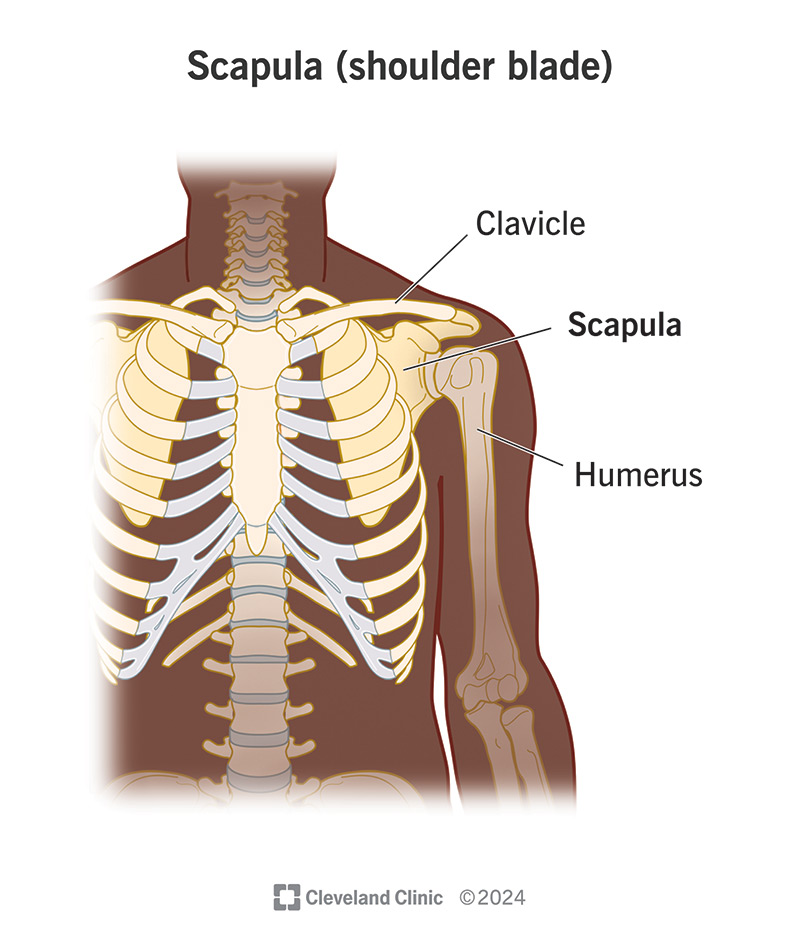The scapula (shoulder blade) is one of three bones that make up your shoulder joint. It forms part of your shoulder’s socket and lets you move and use your shoulder. It’s connected to more than a dozen muscles, tendons and ligaments.
Advertisement
Cleveland Clinic is a non-profit academic medical center. Advertising on our site helps support our mission. We do not endorse non-Cleveland Clinic products or services. Policy

The scapula is a bone in your shoulder. People more commonly call it the shoulder blade.
Advertisement
Cleveland Clinic is a non-profit academic medical center. Advertising on our site helps support our mission. We do not endorse non-Cleveland Clinic products or services. Policy
The scapula is one of three bones that forms your shoulder joint. It connects your clavicle (collarbone) to your humerus (upper arm bone).
Visit a healthcare provider if you’re experiencing shoulder pain, especially if your shoulder hurts after a fall or sports injury. Shoulder blade injuries are usually rare, but anything that damages or irritates your shoulder can affect them, too.
The scapula has several important functions:
Your shoulder blade is part of your axial skeleton (the bones in the center of your body). You have two shoulder blades (scapulae, the plural of scapula), one on each side of your chest. They’re behind your clavicles near your back.
Advertisement
The scapula’s flat, triangular shape is why people call it the shoulder blade. Even though it’s one bone, the scapula has three surfaces:
The scapula’s costal surface is the front — the side that faces your ribcage. The main part of the costal surface forms a slightly indented cup (the subscapular fossa) that supports one of your rotator cuff muscles. A small, hooked bump just under your clavicle (the coracoid process) anchors three muscles.
The scapula’s lateral surface is its outside edge that points toward your humerus. It includes the:
The posterior (inferior) surface of the scapula is the rear part that faces your back. It includes the:
Shoulder injuries are common. That’s because it has so many complex parts and you use it almost constantly throughout your daily routine and activities. It’s rare to hurt your scapula on its own, but shoulder injuries can damage it, including:
Shoulder fractures (broken shoulders) can include fracturing your shoulder blade, but it’s very rare. The scapula is usually only broken during severe traumas like car accidents or falls off a ladder.
Health conditions that affect your shoulder (including your scapula) include:
It’s rare to injure or damage your shoulder blade without hurting other parts of your shoulder. The most common signs of a shoulder injury usually include:
A healthcare provider might use a few types of diagnostic or imaging tests to take pictures of your scapula and the area around it, including:
Advertisement
Which treatments you’ll need depend on which injury or health condition you have.
Some treatments you might need include:
Eating nutritious foods and getting plenty of physical activity are usually all you’ll need to do to keep your shoulder blades healthy.
Follow these general safety tips to reduce your risk of an injury:
You might only think about them when you’re doing a big, satisfying stretch first thing in the morning, but your shoulder blades are important bones that you use almost constantly. They support and move your shoulders and hold lots of muscles and other tissue in place.
Usually, your shoulder blades will function without needing special checkups or care. But don’t ignore shoulder pain, especially if it lasts for more than a week. Visit a healthcare provider if you’re experiencing pain, stiffness or other symptoms that make it hard to do all your usual activities.
Advertisement
From sudden injuries to chronic conditions, Cleveland Clinic’s orthopaedic providers can guide you through testing, treatment and beyond.

Last reviewed on 02/07/2024.
Learn more about the Health Library and our editorial process.